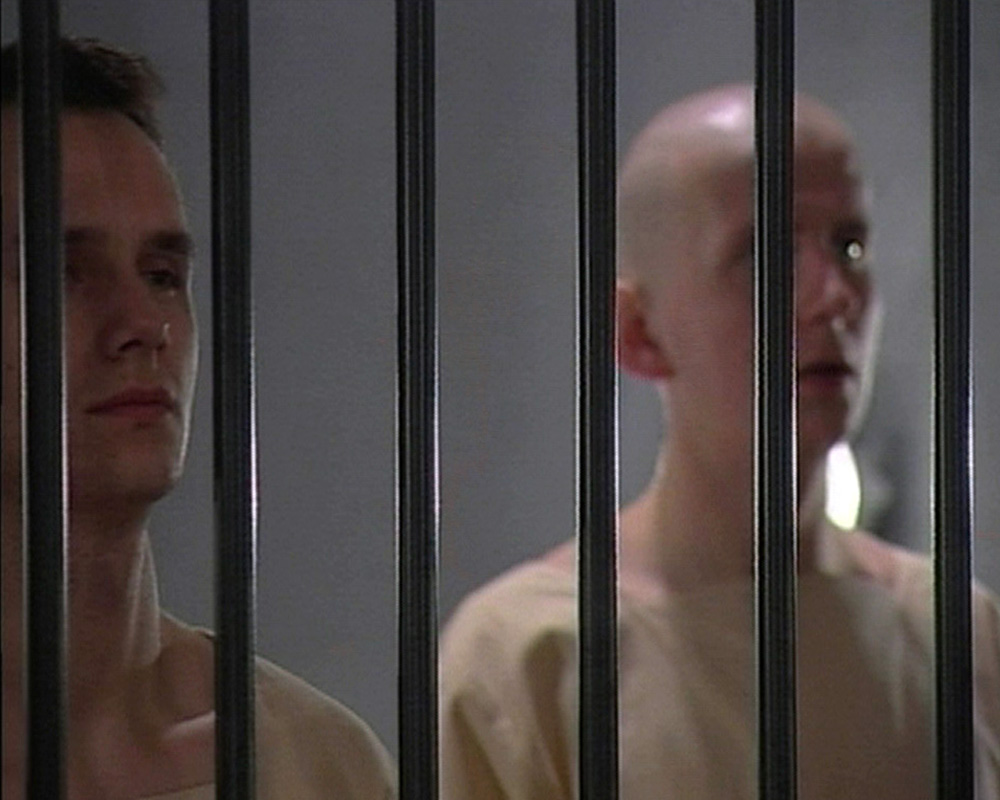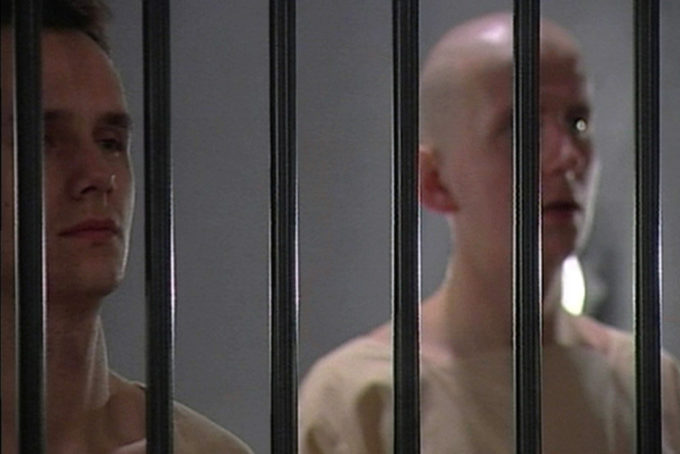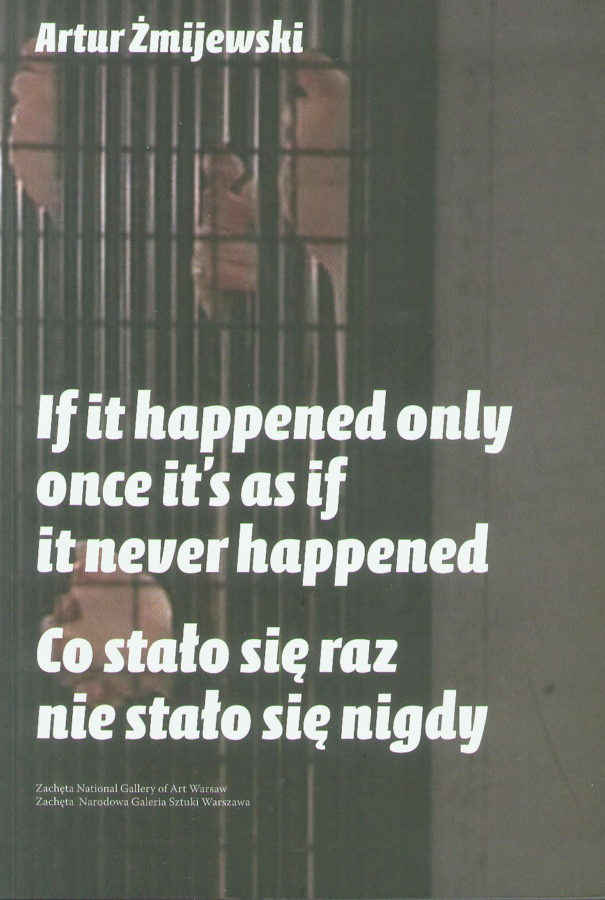
Repetition
Artur Żmijewski
The main feature of the Polish Pavilion at the 51st International Art Exhibition — la Biennale di Venezia was the presentation of a new film by Artur Żmijewski called Repetition. The film is a documentary recording of the re-enactment of the Stanford Prison Experiment – a famous 1971 psychological experiment studying human behaviour in prison conditions, conducted by professor Philip Zimbardo at the US Stanford University. The purpose of the experiment, which consisted in isolating a group of volunteers playing the roles of inmates and guards, was to analyse two issues. First, the patterns determining how people will behave in a new situation. Second, the different perception of a given situation by people of the same background but forced to play different roles (inmates and guards). Professor Zimbardo’s experiment, which had been supposed to run for two weeks, had to be interrupted after just six days, as both groups started manifesting behavioural patterns normally regarded as pathological: sadism, violence, humiliation. Thirty four years later, the Stanford Prison Experiment remains a source of inspiration for psychologists, sociologists, and filmmakers alike. The debate on its results was recently revived by the revealing of the acts of violence at the US military prisons at the Guantanamo base in Cuba and Abu Ghraib in Iraq.
The risk of reconstructing professor Zimbardo’s experiment was taken in early 2005 in Warsaw by Artur Żmijewski – an artistic radical who, in his film trips into the past, confronts dysfunctions of human body, historical traumas, the disintegration of the will and memory. Żmijewski tried to precisely recreate the architecture of the simulated prison and its rules. Seven “prisoners” and nine “guards” were selected through a procedure, involving psychological tests and examinations, aimed at eliminating mentally unstable candidates. The rooms were equipped with Venetian windows (one-way mirrors), and the course of the experiment was filmed by five man-operated cameras and several night vision-enabled industrial TV cameras. Besides the “inmates” and the “guards,” the experiment’s other participants included psychologists acting as experts, capable of stopping the experiment if things turned dangerous, a former prison inmate, and a sociologist involved in prison system reforms. The experiment lasted for seven days. Making Repetition, Żmijewski referred, not for the first time, to the aesthetics of violence and segregation. The artist often plays the role of a „laboratory scientist,” arranging quasi-therapeutic situations: a choir of deaf children trying to sing Bach’s cantatas (Singing Lesson), amputees and able-bodied people forming bodily hybrids (Eye for Eye), or a group of naked people playing tag in the gas chamber of a former Nazi death camp (The Game of Tag). Dramatic events from the past return in Żmijewski’s films deformed, processed by the imperfect memory, rendered unreal. His works are often comments on the processes of victimisation, stigmatisation, exclusion – subjects studied by social psychology. Reaching for the Zimbardo experiment is a natural consequence of the artist’s interests. The Repetition stands among the most complex and challenging works by Artur Żmijewski to-date.
- YEAR2005
- CATEGORY Biennale Arte
- EDITION51
- DATES12.06 – 06.11
- COMMISSIONERAgnieszka Morawińska
- CURATORJoanna Mytkowska
The Limits of an Experiment - Joanna Mytkowska's curatorial statment
Artur Żmijewski will present, in the Polish Pavilion at the 51st International Art Exhibition — la Biennale di Venezia, his new film Repetition. The film is an edited documentary record of a repetition of the psychology experiment originally conducted in 1971 at Stanford University in California by Professor Philip Zimbardo and known as the Stanford Prison Experiment. The film will be screened every hour on the hour.
Professor Zimbardo’s experiment consisted of selecting a group of volunteers, randomly allotted the role of guard or inmate, and putting them in a simulated prison setting in order to observe their behaviour. The experiment produced surprising results. Firstly, the subjects, ordinary university students, quickly identified themselves with their roles of guard or inmate. Almost forgetting this was only an experiment, they very intensely experienced the situation in which they found themselves. Furthermore, the guards quickly started tightening the rules of the fictional prison. As physical violence was strictly prohibited, they found other ways to abuse their power and humiliate the prisoners more and more. Some inmates defended themselves, defied orders, or became emotionally disturbed, and were released from the experiment. Instead of the planned two weeks, the experiment lasted only six days before it was terminated due to the deteriorating mental state of the inmates and the escalation of psychological violence, which threatened to end in an outbreak of uncontrolled aggression. Zimbardo interpreted what had happened as proof that participants were quite prone to succumb to the psychological situation in which they found themselves, even an accidental one. Moreover, this was meant to prove that people were, under the proper circumstances, quite prepared to use and abuse force. Irrespective of their background, education, or other predispositions, the guards agreed to, or themselves initiated, the humiliating treatment of inmates. The experiment was also supposed to be an argument against the existing prison system as an ineffective method of rehabilitation, and, more broadly, against any repressive structure that might evoke the darker side of human nature. From the very beginning, the results and interpretation of the experiment aroused great controversy. More humanistically minded thinkers like psychoanalyst Erich Fromm criticised Zimbardo’s conclusions as too far-reaching and insufficiently based on documented evidence. Particularly controversial was the role of Zimbardo himself, who had played the role of prison superintendent, and become emotionally involved in the course of events. Despite these objections, the experiment (along with Stanley Milgram’s research on the role of authority in social behaviour) became one of the most well-known proofs of the existence of immanent evil in human nature. It went down in the collective consciousness as a scientifically verifiable mechanism for the generation of evil, one that always repeats itself and which may be a significant factor in explaining egregious crimes like genocide or ethnic cleansing. The debate around the Stanford Prison Experiment recently broke out again, even outside scientific circles, following the revelations of the acts of violence at American military prisons at Guantanamo Bay, Cuba and Abu Ghraib, Iraq. This time, Professor Zimbardo’s findings from over 30 years earlier were used to explain abuses by Americans soldiers who mistreated their Iraqi prisoners. Zimbardo himself appeared in court as a witness for the defence, arguing that if prisons by definition were a stimulus for guards to use violence, the latter were but victims of a faulty system. In his work Artur Żmijewski attempts to verify the credibility of various assumptions about human behaviour, and in so doing, often reveals an ambiguous and uncomfortable truth about human nature. His projects often resemble experiments, though decidedly not scientific ones. He invents situations his subjects have to cope with – and emotionally involve themselves in. What he records on tape is a document of actual reactions to an invented scenario. Memory of the trauma of history, a frequent motif in his work, is worked through by symbolically repeating past situations. In the context of Żmijewski’s range of interests, the repetition of Zimbardo’s now mythologized experiment appears a logical complement to his artistic research. Żmijewski redoes a scientific experiment, just as he earlier returned to historical events so dramatic that remembering them had become a difficult task. A scientific experiment supposed to prove that certain forms of behaviour are typical of human nature has here been treated by him
in analogical fashion.
Artur Żmijewski repeated the Stanford Prison Experiment in Warsaw in early 2005 to see whether the machine of evil as described by Zimbardo, still operated, whether it always worked in the same way, and whether this generation of evil could be observed under laboratory conditions. He strove to create an exact model of all the elements of the original Stanford experiment, and to precisely recreate the initial conditions the layout of the simulated prison, the participants’ uniforms, and so on. The participants – seven inmates and nine guards – were selected from among the many volunteers who had replied to a advertisement in the press, after psychological testing and examination whose purpose was to select only subjects who would be mentally strong and stable, and with no history of trauma, addiction, or aggressive tendencies. The inmates were ‘arrested’ in their homes by guards and the artist, transported blindfolded to a ‘prison’ in an unknown location, deprived of their personal belongings, photographed, and confined in cells. The guards were outfitted with appropriate insignia of authority, instructed in a general way as to their duties, and encouraged to independently design rules and regulations for the facility entrusted to them. Because the whole experiment was to be recorded, all the rooms were equipped with one-way mirrors through which the participants were observed by four manned and nine fixed cameras. The experiment was also attended by psychologists acting as experts, authorised to terminate the experiment at any threat of danger, a former prisoner (with 17 years’ experience behind bars) as counsellor, and a sociologist involved in prison reform. The experiment lasted for seven days. Its course, however, took on a different character than the original Stanford Prison Experiment. First all, it began in a very tense atmosphere brought on by psychologists’ concerns (unjustified, as it turned out) that it might result in traumatic experiences and thus affect the participants’ mental state. For this reason additional safety measures were put in place: outside experts were hired, and participants had the right to leave the prison immediately after uttering a pre-defined formula, with no need to give a reason. Moreover practically all the participants had prior acquaintance with the course of the original 1971 experiment, which in the ensuing 30 years had become general knowledge. The close documentation of the proceedings, provided by introducing cameras during the ‘arrests,’ as well as the participants’ awareness that their every move was being filmed, could evoke associations with a TV reality show, and this presented an additional difficulty in creating a credible prison world.
The results of the Warsaw experiment demonstrate that it is rather difficult to awaken the beast in man. The participants for a while simply ‘played’ the roles of guard or inmate, truly embodying them only towards the end of the experiment. This may have been a result both of the above-mentioned factors which made it so difficult to create an artificial world, and of cultural differences, stressed by the experts, in the way Poles and Americans identify with their social roles or with authority. Unlike the 1971 experiment, the guards, though they applied themselves to their work, did not regard themselves as the real authority in the ‘prison.’ Instead, both guards and inmates tended to perceive the experiment’s organisers as that authority – a factor that was not present (or was hidden) in the original Zimbardo experiment. A tendency to locate the centre of power outside one’s own reach appears to have had a fundamental impact on the results of the experiment. What dominated was a readiness to negotiate, to seek consensus between the inmates and their guards, although one based on a desire to observe the rules. Only when encouraged by the organisers did the participants intensify their rivalry for power in the prison, which eventually led to a breakdown of the consensus initially worked out. Under outside pressure, guards and inmates antagonised their positions Eventually, however, reason prevailed over the escalation of violence and radicalisation of attitudes. The intense experiences and violent reactions meant that the participants experienced more strongly the humiliating situation in which they found themselves. In the end, they revolted together against authority – against the experiment’s organisers. The question of how to compare artistic and scientific experiments should be left open. The experiment conducted by Żmijewski shows that, as a machine of evil, a simulated prison is not a perpetual-motion machine. At the very least, some outside impulse seems necessary, a conscious action aimed at escalating violence, as otherwise people will manifest a desire to resolve conflicts. Nor does the will to possess and use power seem to be a universal motivation in human behaviour. The possession of power can be perceived as a burdensome obligation rather than as an advantage, Artur Żmijewski repeated an experiment whose interpretation strongly influenced our understanding of the nature of evil, just as earlier he attempted to recreate trauma from past events, as in the tattooing of a death-camp prisoner (80064, a film from 2004). Those artistic acts of repetition of history seemed to be guided by the thought that everything could in fact happen again if nothing has changed in the nature of things. Mechanisms that once triggered dramatic events can be set into motion again. The ‘repetition’ of an experiment shows how much it is a document of its time and place, how much its interpretation depends on circumstance, and how often social psychology mistakes the subject of its research for its aim. Scientific understanding of the mechanism of evil appears rather distant, and attempts to contain it in social life with experimental methods are a dangerous utopia. Evil remains a dark mystery that manifests itself when we least expect it.
About The Stanford Prison Experiment
The Stanford Prison Experiment (1971) conducted by prof. Philip Zimbardo was to study two questions. One was how the norms according to which one behaves in new situations develop.The other was how perceptions of a given situation (in this case, the experience of imprisonment) by individuals of identical backgrounds forced to play
different roles (prisoners or guards) differ. Zimbardo was also interested in ‘labelling’ and its impact on behavior and self-control. Would the behavior of people chosen to play the roles of prisoners or guards begin to reflect the conditions existing in a real prison – and if so, how soon?
Zimbardo decided to create a simulation of such prison conditions. Twentyfour people were chosen for the experiment, students selected on the basis of diagnostic testing and interviews by a psychologist. They were to spend between five days and two weeks, depending on their ‘sentence,’ in this artificial prison. Prisoner and guard roles were assigned at random. The prison, called Stanford County Jail, was set up in the corridor of a building on the Stanford University campus. It consisted of three small cells containing only beds with blankets and pillows. Several rooms in an adjacent wing were allotted to the guards. Participants had to submit to a very strict regimen. Prisoners were informed they were now to be obedient members of a ‘correctional community.’ Guards received no specific training as to their duties with respect to either the ‘superintendent of the prison’ (Zimbardo) or the volunteer inmates. They were, however, prohibited from using physical violence. It was assumed that, with the rules being so general, many types of interaction would develop within the group, including friendly ones.
Only candidates with no record of anti-social behavior or history of crime or drug abuse were accepted. It was important that participants had no prior acquaintance with each other, as there was a risk (profoundly justified, as it later turned out) that ties of friendship might be jeopardized. The informedconsent agreement contained a warning that the project would involve ‘loss of privacy,’ and that prisoners would not be allowed to withdraw from the experiment except for ‘health reasons.’6 Volunteers also had to agree to have their behavior monitored during the experiment, through audio- and videorecording, interviews, and psychological tests. Significantly for this artificially re-created situation, participants were prohibited from using the terms ‘experiment’ or ‘simulation.’ The rules made it clear that until they were released, inmates were deemed to be in jail. Emphasis was put on the deindividuation of the participants – guards wore khaki uniforms and dark glasses that prevented eye-contact, and were armed with wooden nightsticks. Prisoners wore loose smocks (resembling, it seems ironic today, Arab tunics) with an identification number, and rubber sandals.
The lack of underclothing was another source of discomfort. They were made to wear nylon stockings pulled over their heads as a substitute for having their heads shaved. Volunteers selected to play the inmates were arrested near their homes by real policemen (Zimbardo secured the cooperation of the Palo Alto Police Department), and underwent the entire arrest procedure as provided by law – fingerprinting, body search, and, upon arrival at the facility, being stripped naked and deloused. Professor Zimbardo’s experiment was planned to last two weeks, but had to be ended after just six days. Members of both groups – prisoners and guards – started to exhibit behavior that under normal circumstances would be regarded as pathological. Guards began showing sadistic tendencies. Having received no explicit instructions on how to handle inmates, they displayed great ingenuity in tormenting and humiliating them. They forced the prisoners to clean toilets with their bare hands, and to perform excruciating physical exercises, such as push-ups, which, as Zimbardo notes, was a form of torture often used in Nazi concentration camps. At night they would order prisoners to undergo ‘counts,’ and sometimes prohibit them from going to the toilet, forcing them to use buckets, and so on. All ‘privileges’ were very quickly cancelled. Prisoners started showing symptoms of emotional disturbance as early as the second day of the experiment. Five had to be released early because of deep depression, anxiety, and outbursts of rage. Moreover, the inmates surprisingly began to identify with their new role, for example, calling each other by number rather than by name (even with a visitor from the ‘real world,’ a Catholic chaplain who was asked to visit the Stanford County Jail). The line separating simulation from the real world was quickly blurred.
an excerpt from The Pathology of Power and the Administration of Humiliation: Professor Zimbardo’s Experiment (Repetition) by Sebastian Cichocki, in the book Artur Żmijewski. If it happened only once it’s as if it never happened, 2005


